Good and Bad Bishop (Detailed guide with pictures)
The Bishop is one of the most powerful and interesting pieces in the game. This is especially true if the position allows it to unleash its full potential.
There are cases however where a position gives preference to one Bishop over the other. This is due to the fact that bishops are of the opposite colors, therefore one will be more useful than the other depending on the situation.
A Good bishop can be identified as a bishop that resides in the opposite colors from where most of the pawns are structured. A Bad Bishop is placed in the same color as most pawns in a way that usually blocks the piece from being activated.
Good Bishop
A good Bishop is simply identified by looking at the corresponding pawn structure. Look at the diagram below:
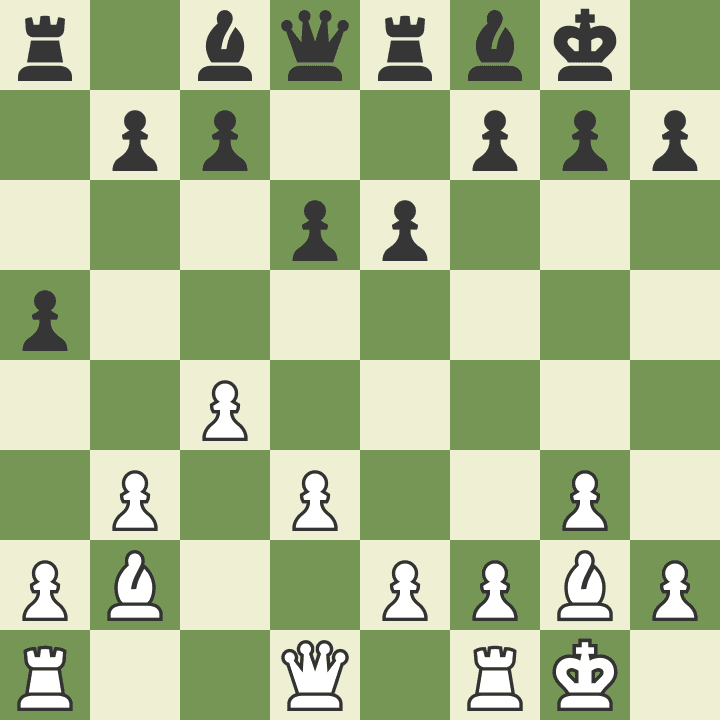
As you can see the Dark squared bishop dominates the position. This is due to the fact that the pawns are placed in a way that allows the bishop to be influential.
There are little to no pawns that have the potential to block the bishop. This makes it capable to impact much larger sections of the board without anything getting in the way.
A good Bishop always resides in the opposite color as most of the pawns. It doesn’t necessarily mean that all pawns have to only reside in one color.
But it does mean that most pawns are placed in a way that doesn’t block the bishop. Look again:
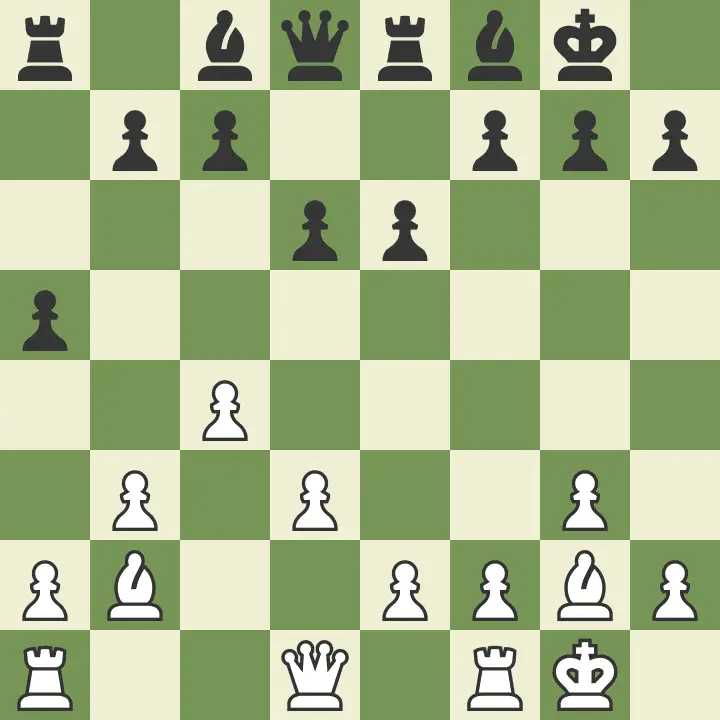
In this example, the light square bishop is also a good bishop. Even though not all the pawns are in the dark square, the area where the light bishop at is. This means that the light-squared bishop is still considered a good bishop as most of the pawns are on the opposite color (at least pawns near the piece).
This is true even when most of the pawns on the other side are on a light square. Now that will look into it, what is a bad Bishop?
Bad Bishop
From the diagram earlier, we have already established that the White’s bishops are the good ones. But how about Black’s Bishops? Here, take a look:
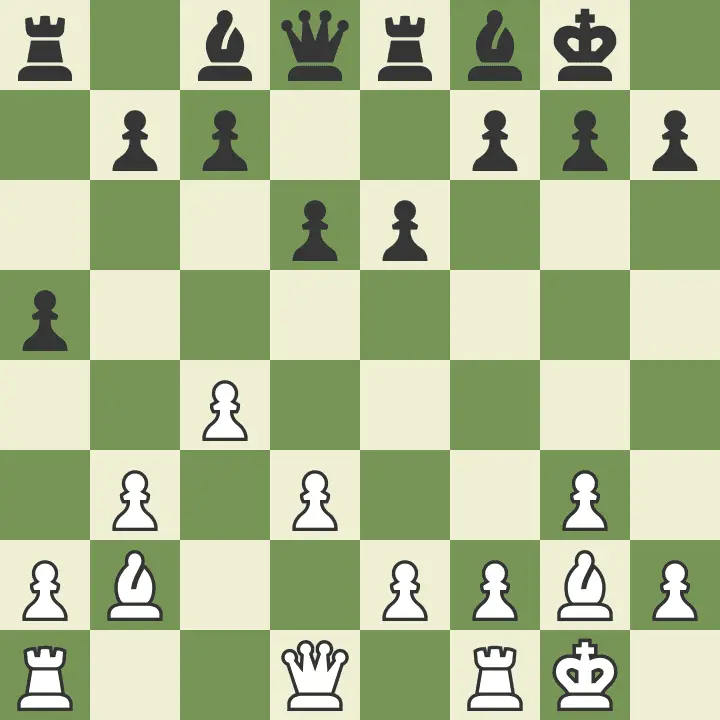
Both of Black’s bishops certainly don’t reside in the opposite color as most of the pawns. In fact it is the opposite, being on the same one!
And as you can see, the pawns are blocking the Bishops from being activated. This is entirely different from a good bishop, black’s bishop cannot unleash their full potential.
Unless the position change a little of course. So how does the position play a role in this?
Positional Factor
The position is not static where it ebbs and flows, a good Bishop will not always be a good one. The position change over time as the two players played the game.
The good bishop can certainly be turned into a good one through the player’s efforts. I mean, the actual definition relies on the color of the pawns.
The pawns will always change structures therefore potentially changing the potential of the Bishops. This doesn’t mean though that this will always be the case.
One thing might be true now but not forever!
A good Bishop can certainly remain a good one if the pawns stayed the same way. This is the same for the bad Bishop. In fact, it is even harder to activate a player’s own bad Bishop than to deactivate the opponent’s good one.
This is due to the fact that breakthroughs are necessary to break a solid pawn structure. The situation below shows how a good bishop outplays the bad one:
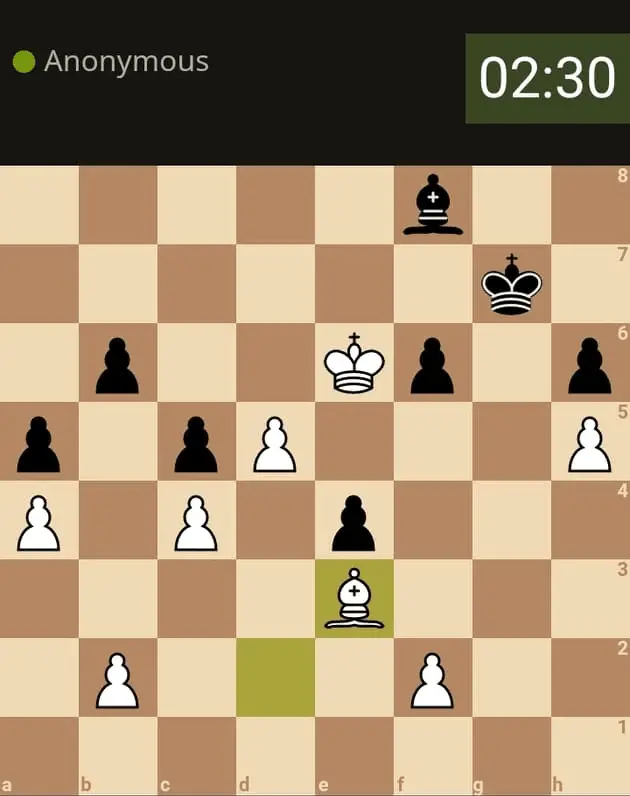
The central pawns in this case for white reside on the light squares. This means that the Dark square bishop for White is a good Bishop.
The Dark Bishop for Black however is a bad Bishop since most of the pawns are on the dark square. How in the world would those center pawns become a light square?
Black would have to sacrifice pawns! It would be significantly harder to convert Black’s dark Bishop into a good one. This is actually why the Knight is better in closed positions (this is not a closed position though).
This is due to the fact that the knight can jump over pieces without getting blocked by the pawns unlike the bishop. I’ve actually written a complete guide over the advantages and disadvantages of Knight against the Bishop which you can click here (will open in a new tab).
Getting back to the topic, it also doesn’t mean that it will always stay the same way. The center pawns may change (not at this one Black is losing obviously).
Opening factor
Having both good bishops is definitely possible However not every opening (initial predefined set of moves) offers the best of places for this piece. And that is totally fine, strengths after all are gained by sacrificing some little weaknesses.
But it’s still necessary for us to identify which openings give the bad and good bishop in order to for us to have a good idea of the position’s characteristics.
White’s Opening (Bishop Factor)
The table demonstrates the 20 most common opening for white.
White’s perspective
This table contains positions set up by playing White. It contains the idea of whether such positions have a good or bad bishop. Of course, these are not the only popular openings there are many more, but these are the ones that you will likely encounter in your games.
Here they are!
| Name | Moves | Light Square Bishop | Dark Square Bishop |
| Ruy Lopez | 1.) e4 e5 2.) Kf3 Bb5 | Good | Unidentified |
| Italian Game | 1.) e4 e5 2.) Kf3 Kc6 3.) Bc4 | Good | Unidentified |
| Scotch Game | 1.) e4 e5 2.) Kf3 c6 3.) d4 | Good | Good |
| King’s Gambit | 1.) e4 e5 2.) f4 | Good | Good |
| London Opening | 1.) d4 d5 2.) Kf3 Kf6 3.) Bf4 | Good | Good |
| English Opening | 1.) c4 | Good | Unidentified |
| Hungary Defense | 1.) g3 | Good | Unidentified |
| Bird Opening | 1.) f4 | Unidentified | Unidentified |
| Nimzo Larsen Attack | 1.) Kf3 d5 2.) b3 | Unidentified | Good |
| Queen’s Gambit | 1.) d4 d5 2.) c4 | Good | Unidentified |
| Center Game | 1.) e4 e5 2.) d4 | Good | Good |
| King’s Indian Attack | 1.) Kf3 d5 2.) g3 | Good | Unidentified |
| Vienna Game | 1.) e4 e5 2.) Kc3 | Good | Unidentified |
| Torre attack | 1.) d4 d5 2.) Kf3 Kf6 3.) Bg5 | Good | Bad |
| Bishop’s Opening | 1.) e4 e5 2.) Bc4 | Good | Unidentified |
| Nyezhmetdinov- Rossolimo | 1.) e4 e5 2.) Kf3 Kc6 3.) Bb5 | Good | Unidentified |
| Mason attack | 1.) d4 d5 2.) Bf4 | Good | Bad |
| Fried Liver attack | 1.) e4 e5 2.) Kf3 Kc6 3.) Bc4 Kf6 4.) Kg5 | Good | Unidentified |
| Sicilian Snyder | 1.) e4 c5 2.) Kf3 | Unidentified | Good |
| Danish Gambit | 1.) e4 e5 2.) Kf3 Kf6 3.) d4 exd4 4.) c3 dxc3 5.) Bc4 cxb2 6.) Bxb2 | Good | Good |
The unidentified means there’s still potential to improve. Or in other words, the bishop is still neither a good nor bad one and can change as the game progresses.
I wish I could embed a Chessboard here or something, the names (of the openings) afterall doesn’t make a difference if we can’t understand what it is. But there’s too many of them, the site will just load really slow.
There is this site called chess.com, a very wonderful site with a lot of tools to boost your chess experience. You can sign up here (will open a new tab) to use their analysis board in order play the given set of moves above.
It’s free, and it even gives the name of the moves. If you can’t read Chess notations then just google it or type the actual name of the moves to see where the pieces belong.
Black’s perspective
From those openings, Black has its own characteristics as well. These are positions from the exact same table above only with the difference of talking about black.
Look at the table:
| Name | Moves | Light Square Bishop | Dark Square Bishop |
| Ruy Lopez | 1.) e4 e5 2.) Kf3 Bb5 | Unidentified | Good |
| Italian Game | 1.) e4 e5 2.) Kf3 Kc6 3.) Bc4 | Unidentified | Good |
| Scotch Game | 1.) e4 e5 2.) Kf3 c6 3.) d4 | Unidentified | Good |
| King’s Gambit | 1.) e4 e5 2.) f4 | Unidentified | Good |
| London Opening | 1.) d4 d5 2.) Kf3 Kf6 3.) Bf4 | Good | Good |
| English Opening | 1.) c4 | Unidentified | Good |
| Hungary Defense | 1.) g3 | Unidentified | Unidentified |
| Bird Opening | 1.) f4 | Unidentified | Unidentified |
| Nimzo Larsen Attack | 1.) Kf3 d5 2.) b3 | Unidentified | Unidentified |
| Queen’s Gambit | 1.) d4 d5 2.) c4 | Unidentified | Unidentified |
| Center Game | 1.) e4 e5 2.) d4 | Unidentified | Good |
| King’s Indian Attack | 1.) Kf3 d5 2.) g3 | Unidentified | Unidentified |
| Vienna Game | 1.) e4 e5 2.) Kc3 | Unidentified | Good |
| Torre attack | 1.) d4 d5 2.) Kf3 Kf6 3.) Bg5 | Unidentified | Good |
| Bishop’s Opening | 1.) e4 e5 2.) Bc4 | Unidentified | Unidentified |
| Nyezhmetdinov- Rossolimo | 1.) e4 e5 2.) Kf3 Kc6 3.) Bb5 | Unidentified | Unidentified |
| Mason attack | 1.) d4 d5 2.) Bf4 | Unidentified | Good |
| Fried Liver attack | 1.) e4 e5 2.) Kf3 Kc6 3.) Bc4 Kf6 4.) Kg5 | Unidentified | Good |
| Sicilian Snyder | 1.) e4 c5 2.) Kf3 | Unidentified | Unidentified |
| Danish Gambit | 1.) e4 e5 2.) Kf3 Kf6 3.) d4 exd4 4.) c3 dxc3 5.) Bc4 cxb2 6.) Bxb2 | Bad | Bad |
This kind of information allows us to determine whether an opening runs an inherent good or bad bishop. It sets a reasonable expectation when choosing the proper opening.
Along with the conditions of the bishop in those openings. Now that’s the most common opening for white. What about the common opening for black?
Black’s opening (Bishop Factor)
Here’s the table just like the one from above. But this time it’s for the black pieces.
White’s perspective
Remember these are openings chosen to be played by Black. The table however are conditions for White.
Here:
| Name | Moves | Light Square Bishop | Dark Square Bishop |
| Caro Kann Defense | 1.) c4 c6 2.) d4 d5 | Bad | Unidentified |
| French Defense | 1.) e4 e6 2.) d4 d5 | Good | Unidentified |
| Pirc | 1.) e4 d6 | Good | Unidentified |
| Phillidor | 1.) e4 e5 2.) Kf3 d6 | Good | Unidentified |
| Scandinavian | 1.) e4 d5 | Good | Good |
| Modern | 1.) e4 g6 | Unidentified | Unidentified |
| Scheveningen Sicilian | 1.) e4 c5 2.) Kf4 d6 3.) d4 cxd4 4.) Kxd4 Kf6 5.) Kc3 e6 | Good | Good |
| Dragon Sicilian | 1.) e4 c5 2.) Kf4 d6 3.) d4 cxd4 4.) Kxd4 Kf6 5.) Kc3 g6 | Good | Unidentified |
| Owen’s Defense | 1.) e4 b6 | Good | Unidentified |
| King’s Indian Defense | 1.) d4 Kf6 2.) c4 g6 3.) Kc3 Bg7 4.) e4 d6 | Good | Good |
| Queen’s Indian | 1.) d4 Kf6 2.) c4 e6 3.) Kf3 b6 | Good | Good |
| Grunfeld Defense | 1.) d4 Kf6 2.) c4 g6 3.) Kc3 d5 | Good | Good |
| Queen’s Gambit Declined | 1.) d4 d5 2.) c4 e6 | Good | Bad |
| Slav Defense | 1.) d4 d5 2.) c4 c6 | Good | Unidentified |
| Symmetrical English | 1.) e4 c5 2.) Kc3 Kc6 3.) Kf3 Kf6 | Good | Unidentified |
| Great Snake | 1.) c4 g6 | Unidentified | Unidentified |
| Dutch Defense | 1.) d4 f5 | Good | Unidentified |
| Cozio Defense | 1.) e4 e5 2.) f3 Kc6 3.) Bb5 Kge7 | Good | Unidentified |
| Giuco Piano | 1.) e4 e5 2.) f3 Kc6 3.) Bb5 Kge7 | Good | Unidentified |
| Najdorf Sicilian | 1.) e4 c5 2.) Kf4 d6 3.) d4 cxd4 4.) Kxd4 Kf6 5.) Kc3 a6 | Good | Unidentified |
You might wonder what about for black? I mean the table focuses on replies for black.
Black’s Perspective
It’s important to be able to know whether the position can give a good and or bad bishop. The black pieces are notorious for having at least one bad bishop most of the time (not always).
So pay attention to this one. Look at the table:
| Name | Moves | Light Square Bishop | Dark Square Bishop |
| Caro Kann Defense | 1.) c4 c6 2.) d4 d5 | Good | Unidentified |
| French Defense | 1.) e4 e6 2.) d4 d5 | Bad | Good |
| Pirc | 1.) e4 d6 | Good | Good |
| Phillidor | 1.) e4 e5 2.) Kf3 d6 | Good | Unidentified |
| Scandinavian | 1.) e4 d5 | Good | Good |
| Modern | 1.) e4 g6 | Unidentified | Good |
| Scheveningen Sicilian | 1.) e4 c5 2.) Kf4 d6 3.) d4 cxd4 4.) Kxd4 Kf6 5.) Kc3 e6 | Unidentified | Unidentified |
| Dragon Sicilian | 1.) e4 c5 2.) Kf4 d6 3.) d4 cxd4 4.) Kxd4 Kf6 5.) Kc3 g6 | Unidentified | Good |
| Owen’s Defense | 1.) e4 b6 | Good | Unidentified |
| King’s Indian Defense | 1.) d4 Kf6 2.) c4 g6 3.) Kc3 Bg7 4.) e4 d6 | Unidentified | Good |
| Queen’s Indian | 1.) d4 Kf6 2.) c4 e6 3.) Kf3 b6 | Good | Unidentified |
| Grunfeld Defense | 1.) d4 Kf6 2.) c4 g6 3.) Kc3 d5 | Good | Good |
| Queen’s Gambit Declined | 1.) d4 d5 2.) c4 e6 | Bad | Good |
| Slav Defense | 1.) d4 d5 2.) c4 c6 | Bad | Good |
| Symmetrical English | 1.) e4 c5 2.) Kc3 Kc6 3.) Kf3 Kf6 | Unidentified | Good |
| Great Snake | 1.) c4 g6 | Unidentified | Good |
| Dutch Defense | 1.) d4 f5 | Unidentified | Good |
| Cozio Defense | 1.) e4 e5 2.) f3 Kc6 3.) Bb5 Kge7 | Bad | Unidentified |
| Giuco Piano | 1.) e4 e5 2.) f3 Kc6 3.) Bb5 Kge7 | Unidentified | Good |
| Najdorf Sicilian | 1.) e4 c5 2.) Kf4 d6 3.) d4 cxd4 4.) Kxd4 Kf6 5.) Kc3 a6 | Unidentified | Unidentified |
See, there is a somewhat fair number of bad Bishops in there (compared to the previous tables). I really want you to see this for yourself. Then again I can put a Chessboard here, but it’s just too long!
General Idea
Now that we’ve learned what they are, it’s time to learn the why. Why is this rule put forth in the first place? What makes it important?
The concept of a good bishop and the bad bishop is based on a principle. This principle relies on the fact that the bishop can only move in one color, as well as the fact that it cannot override any piece that resides on the tile.
This means that anything in particular colors would be a potential blockade to the piece. This principle ensures to teach players the nature of the bishop and how it functions.
It gives beginners a sense of the following:
- Blocks- Bishops cannot foster in a closed position without space.
- Development- Bishops need an open line to be activated.
- Exchange- A means to determine whether trading a bishop is viable.
- Basis- A way to determine which Bishop is worth keeping.
- Endgame- Whether an endgame should be winning.
- Opening- A way to position the Bishop in becoming useful early in the game.
- Pawn structure- An understanding of the Bishop’s role in a specific structure preferred by the player.
These are all legitimate ways to assure that the player makes good decisions in the game. That is of course regarding the nature of the bishop.
A beginner can place the bishop away in a not so useful square. This rule is just to avoid something like that from happening.
Active Bishop
Now you might be wondering what up about the subheading on this one. Active bishop? Isn’t that just a good bishop? Well, not necessarily.
Actually, something that we considered good can actually be an inactive Bishop! That seems crazy but that’s due to the way it was defined in the first place.
A good bishop is defined as having placed on the opposite color. This is of course not only on the overall pawn structure but rather the area the bishop resides from.
There are however situations in chess where just having the opposite color doesn’t ensure a lot of space. A piece may not get activated even though its own pawns give it some space.
This is due to the fact that the opponent’s own pawns are a factor here. Just because your own pawns don’t get in the way does not mean your opponent’s pawns won’t.
A Bad Active Bishop
To demonstrate this further here’s a screenshot I’ve got from Lichess. Lichess by the way is another popular platform to sign up apart from Chess.com. You can use that if you want to, but I still recommend chess.com.
Just happened to play an unrated game very quickly while writing this. Anyway, this is crazy! This endgame just came out from my game to be used as a reference.
Take a look at this screenshot I had from lichess this morning:
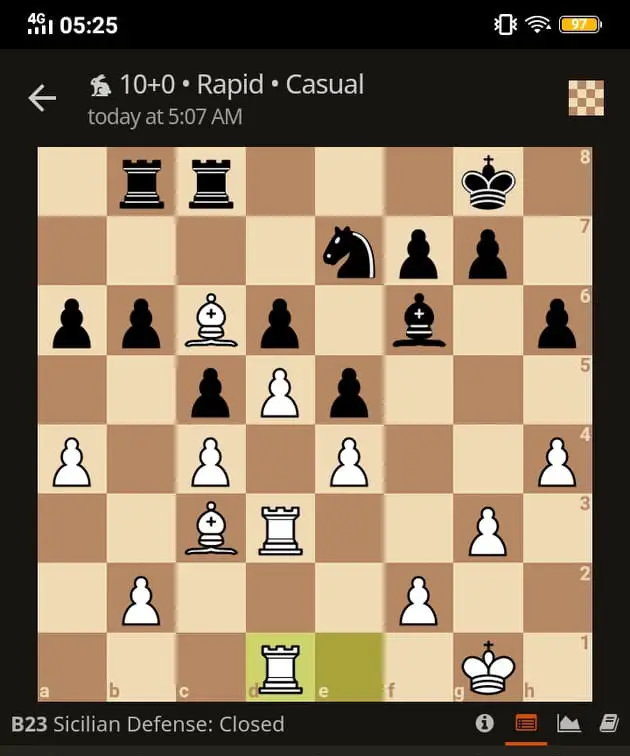
Based on the definition which is a good and bad Bishop? The light square bishop resides in the same color as most of the pawns around it. This makes it the bad bishop But does it look active? Does it look like it functions well?
Obviously yes! It is doing a lot of stuff to keep the Queenside in place. As well as control the rook’s placement on their own ranks. This is why black tries to get rid of it by attacking it with the Knight.
It’s pretty annoying actually. So, just because it’s a bad bishop doesn’t mean it cannot be active or not useful. Sometimes it is even more useful than the actual “Good” bishop. But let’s backtrack for a second.
What about the dark square bishop in this case? Let’s look at it.
Inactive Bishop
We’ve already established how a bad bishop can actually be useful. But the other way around is true. A good bishop doesn’t necessarily mean a useful one either.
It’s just likely to have that characteristic, but not always. Let’s take a look at that screenshot one more time:
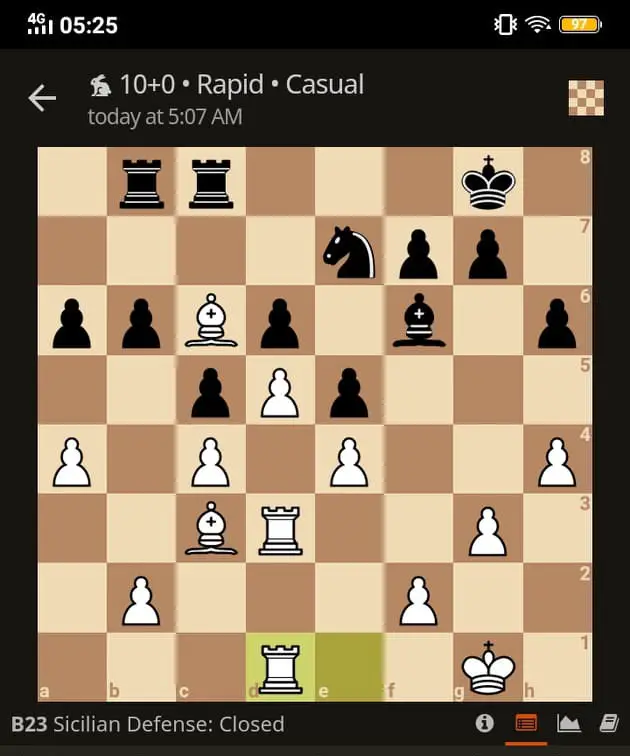
Take a look around the area in which the dark bishop resides. It is an area full of pawns of the opposite color. Yet, the bishop doesn’t look very useful in this event.
I mean even the center pawns are of the opposite color. Clearly this is supposed to be the good bishop. So why is it not very helpful, the so-called inactive?
A good inactive Bishop
The dark square bishop is considered inactive as it is still blocked by the pawn. Maybe not of the player’s but of the opponent’s. There might be some space in order for the bishop to have a little of control. But that space is limited by these blockading opposing pawns.
Therefore, this supposed to be “good” bishop isn’t that powerful at all. In fact, it is a pain to develop this Bishop. Every possible square is already influenced by the pawns of the other player. Take a look again, there aren’t any tiles for the Bishop to transfer to.
Hmmm active, inactive is not good and bad?
It can’t be better because there aren’t better squares. This inactive bishop is not utilized properly. It almost looks like a pawn. So the dark-squared Bishop in this case is an inactive Bishop. The Dark square bishop resides in an area that has pawns of the opposite color.
This would make it the Good Bishop. Since by definition it’s on the opposite color of the pawns. But it doesn’t make it helpful as it is not doing much. So how can you differentiate the good and bad from the active and inactive one?. It is confusing after all.
Differentiation
You might spin your head around the fact that good and bad is not equal to active and inactive. They might be harder to identify due to this confusion. Here are ways to possibly identify an active and inactive bishop (since I think it is more important). Even ignoring the fact of whether they are good or bad.
Opponent’s Pawn
I may have alluded to this somehow in my earlier statements. But the reason a bishop becomes active or inactive has to do with the opponent’s pawns.
The pawns can block the bishop’s influence supposedly. This is especially true upon blockaded centers. Look at diagram below:
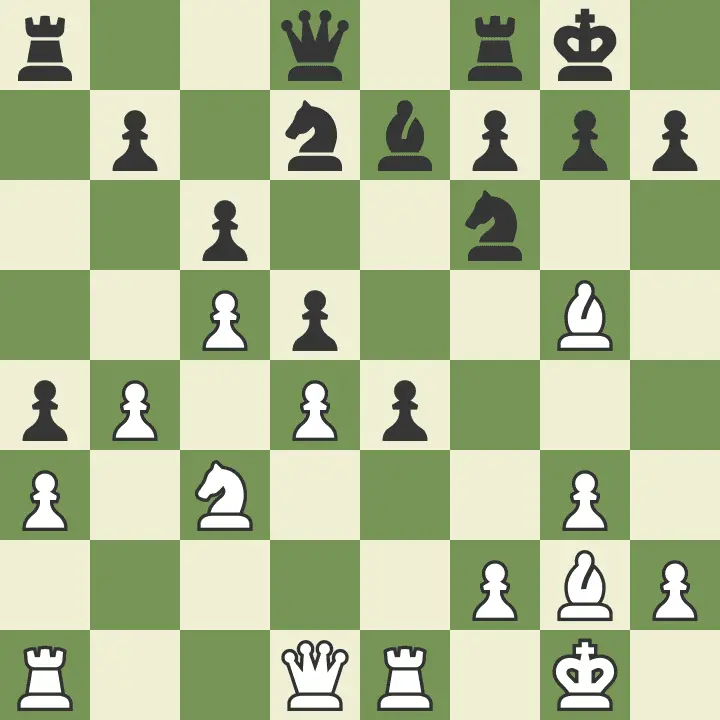
The light square bishop for white is a good Bishop. Since it is in the opposite colors of the pawns.
But it is an inactive one at the same time. Due to the fact that the blockaded center has opponent pawns of the same color. Another one would be pieces.
Opponent’s Pieces
Pawns are not the only thing that could block the bishop. A piece can do that as well. Look at the picture below.
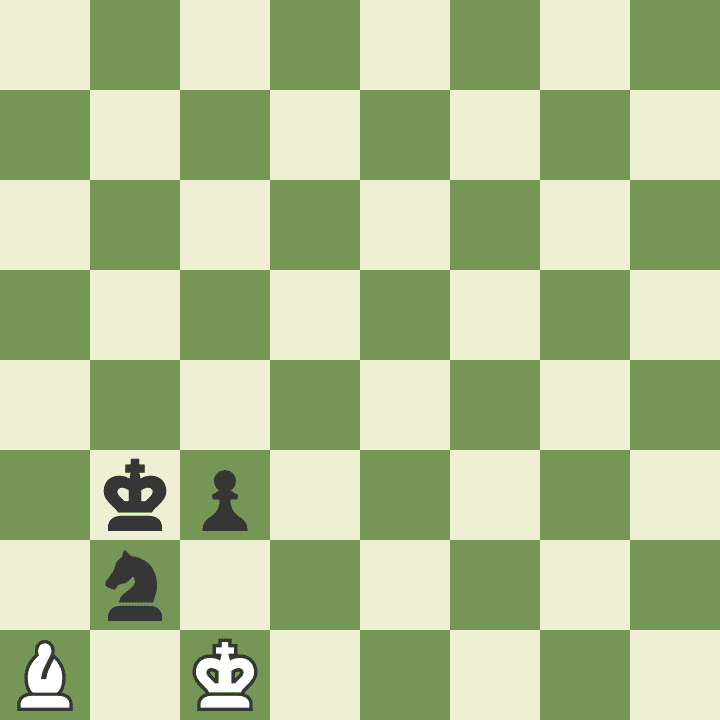
This kind of scenario usually happens in end games. Endgame is the phase of the game where there are a little number of pieces left. The perks of the Dark Bishop in this case is being a Good Bishop. Since its own pawn doesn’t block its path.
However, it is still an inactive Bishop. This is due to the fact that the Knight blocks the bishop from being activated. And although it’s own pawns doesn’t block it, the opponent’s piece does, that means it doesn’t count.
This is just one sample. It can certainly happen earlier in the game, it’s just more frequent later since most endgames are very crucial to win the game. Earlier, it is still important but not as important as in Endgames.
Pawn Chain
I just talked about looking for the opponent’s pawn. But how about your own pawns? There is of course a way to know an active and inactive Bishop through your own pawns.
It is similar to the Good and Bad bishop. Just in a slightly different way. At this example, notice how the bishop is behind the pawn chain (pawns structured side by side).
Just look :
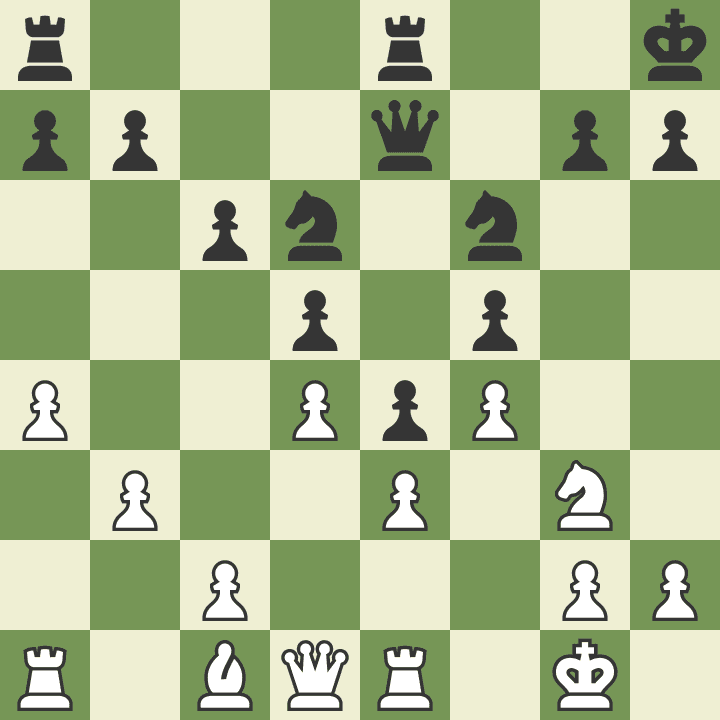
And this is certainly a good yet inactive bishop.
But how about this picture: The dark square bishop in this case is a bad bishop but a very active one.
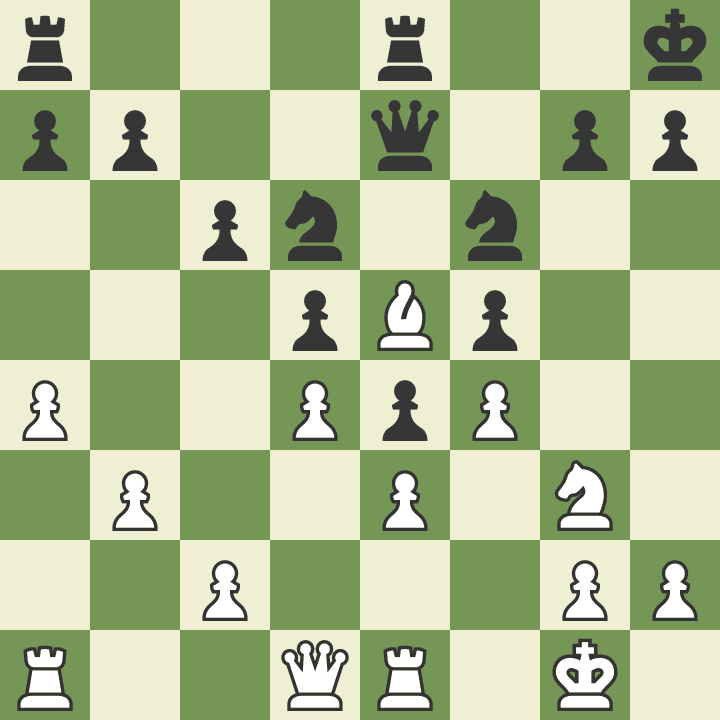
So what’s the difference? The bishop’s placement of course! The first picture’s bishop is behind the pawn chain.
The second one is outside the pawn chain. Pawn chains are basically pawns placed side by side. The bishop that’s behind the pawn chain is blocked from being activated.
On the other hand, the pawn that is outside the pawn chain is actually pretty useful. And therefore deserves to be called an active Bishop.
Defending Pawns
If you’ve seen the video then you must have seen the bishop that protects the lonely pawn. Here’s a similar situation to further illustrate this:
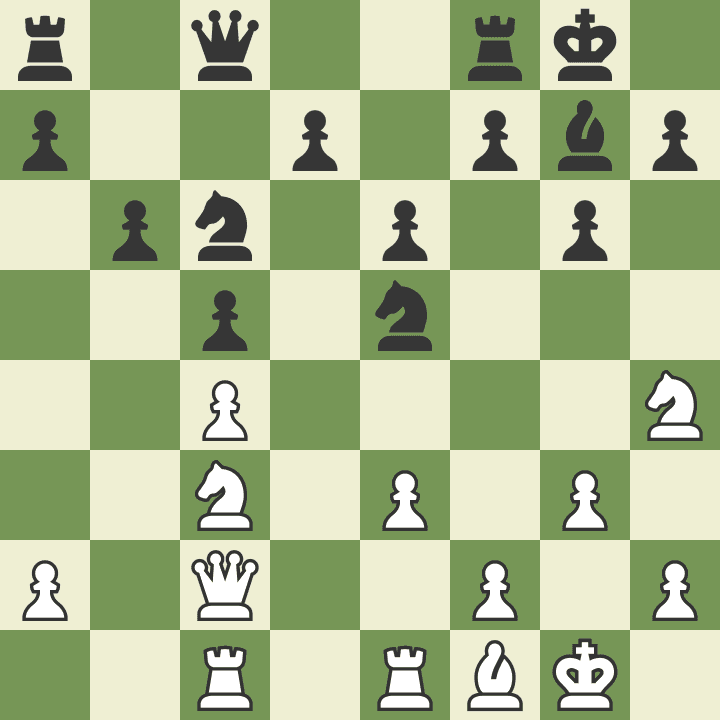
You can see that White’s light bishop is defending the pawn. It’s supposed to be a good bishop since it is in the opposite colors.
However, it is inactive in this case since it is too occupied defending one of the pawns. The lonely pawn actually becomes a burden.
If you think about it, it’s as if the bishop is being blockaded by that pawn. Since it can’t go anywhere else the pawn will fall.
The bishop is inactive because of the defended pawn. These factors can help us identify an active, from an inactive one. Which brings us to the next issue.
Bad term
Why exactly do we call a bishop as good or bad? Why can’t we just say it as active or inactive. Since that would be the more accurate way to describe the placement of the bishop anyway. And you might actually be correct to think this.
Beginner Mindset
The good and bad bishop is an idea specifically targeted for beginners. It teaches those who are just learning the game how the bishop needs space.
It is significantly harder for someone who is just starting the game to know active from inactive. This is why people just teach the principle.
This is because it is much easier to identify than the active inactive one. A player just has to look at the surrounding pawn structure to identify which bishop is better.
Of course this is not always accurate. However for beginners, this is actually a likely scenario occur. That is a good bishop being active, as well as a bad bishop being the inactive one. Looking for active and inactive is a much more complicated process. So that’s why they teach that.
Breaking the rules!
I don’t know if you noticed this in chess. But the principles you learned as a beginner actually become non-efficient once you get good at the game. This is due to the fact that was mentioned earlier.
Principles are just in place to let you get a sense of the game’s nature. But the game of Chess is really complicated. And there is no one or two principles that could actually explain it.
So if you pigeonholed yourself to these principles, you will never achieve the heights you want to reach. So don’t worry much about principles they are the guide not the boat!
Conclusion
Learning the good and bad bishop and its principles is a good way to understand their intrinsic nature. It allows you to properly evaluate the bishop’s value and make proper trades
There are situations however where the bishop’s value becomes relative. You’ll learn it overtime! I think you must be a smart person since you’re reading this- maybe.
Check out my homepage for more cool chess infos!
